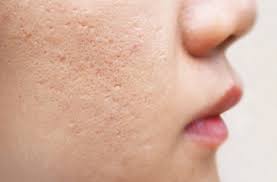
Skin care routine for acne-prone, sensitive skin.
Creating a unique and effective skincare routine for acne-prone, sensitive skin involves selecting gentle yet effective products that address acne without causing irritation or exacerbating sensitivity. Here’s a comprehensive guide tailored to your skin type: Incorporating tretinoin cream into your skincare routine for acne-prone, sensitive skin requires a careful approach to minimize irritation while maximizing its acne-fighting benefits. Here’s a step-by-step guide to help you effectively and safely use Tretinoin cream
Understanding Acne-Prone, Sensitive Skin
Acne-prone, sensitive skin is characterized by a tendency to develop pimples, blackheads, or cysts, often accompanied by redness, dryness, or a feeling of tightness. Managing this skin type requires balancing acne treatment with soothing and hydrating ingredients to maintain skin barrier integrity and prevent irritation.
Step-by-Step Skincare Routine
1. Cleaning (Morning and Evening)
Purpose: To remove excess oil, dirt, and impurities without stripping the skin.
- Choose a Gentle Cleanser: Opt for a fragrance-free, non-comedogenic cleanser formulated for sensitive skin. Look for ingredients like ceramides, glycerin, or hyaluronic acid for hydration.
- How to Use: Gently massage a small amount onto damp skin using circular motions. Rinse thoroughly with lukewarm water. Pat dry with a soft towel.
2. Toning (Optional)
Purpose: To balance the skin’s pH and provide additional hydration or soothing benefits.
- Choose a Alcohol-Free Toner: Look for soothing ingredients such as rose water, chamomile, or witch hazel (without alcohol) to calm and hydrate the skin.
- How to Use: Apply toner to a cotton pad and gently swipe over your face and neck. Allow it to absorb before proceeding to the next step.
3. Treatment (Targeted Acne Treatment)
Purpose: To treat existing acne and prevent new breakouts without causing irritation.
- Choose a Gentle Acne Treatment: Look for products containing ingredients like:
- Salicylic Acid: Exfoliates inside the pores and reduces inflammation.
- Benzoyl Peroxide: Kills acne-causing bacteria and reduces oil production.
- Sulfur: Helps to unclog pores and reduce inflammation.
- How to Use: Apply a thin layer of acne treatment to affected areas or as directed by your dermatologist. Start with once daily application and gradually increasing frequency as tolerated.
4. Moisturizing (Morning and Evening)
Purpose: To hydrate and protect the skin barrier.
- Choose a Non-Comedogenic, Fragrance-Free Moisturizer: Look for lightweight formulas that provide hydration without clogging pores or causing irritation.
- How to Use: Dispense a small amount and gently massage onto your face and neck. Allow it to absorb fully before applying sunscreen or makeup.
5. Sun Protection (Morning)
Purpose: To protect the skin from UV damage and prevent post-inflammatory hyperpigmentation.
- Choose a Mineral-Based Sunscreen: Look for broad-spectrum protection with SPF 30 or higher. Mineral Sunscreens containing zinc oxide or titanium dioxide are less likely to cause irritation.
- How to Use: Apply sunscreen generously to all exposed areas of the skin. Reapply every 2 hours, especially if outdoors, after sweating or swimming.
6. Weekly Treatments (1-2 Times per Week)
Purpose: To exfoliate dead skin cells gently and promote skin renewal.
- Choose a Mild Exfoliant: Opt for chemical exfoliants containing alpha hydroxy acids (AHAs) like glycolic acid or lactic acid, which are gentler on sensitive skin compared to physical scrubs.
- How to Use: Follow the instructions provided with your exfoliant. Start with once a week and adjust based on your skin’s response.
7. Hydration (Throughout the Day)
Purpose: To maintain skin hydration and overall skin health.
- Drink Plenty of Water: Hydration from within helps maintain skin elasticity and clarity.
- Use a Humidifier: Especially in dry climates, to add moisture to the air and prevent skin dryness.
Additional Tips for Acne-Prone, Sensitive Skin
Diet and Lifestyle
Using Elocon Cream for acne-prone, sensitive skin is not typically recommended as a first-line treatment for acne due to its formulation and intended use. Elocon Cream contains mometasone furoate, a potent corticosteroid primarily prescribed for inflammatory skin conditions such as eczema or dermatitis, rather than acne.
- Balanced Diet: Avoid foods that can trigger acne flare-ups, such as dairy and high-glycemic foods.
- Stress Management: Stress can worsen acne and sensitivity. Practice stress-relieving techniques like yoga, meditation, or deep breathing exercises.
- Regular Exercise: Promotes circulation and helps regulate hormone levels, which can impact acne.
Skincare Dos and Don’ts
- Do: Clean your makeup brushes and other applicators regularly to prevent bacterial buildup.
- Don’t: Pick or squeeze acne lesions, as it can lead to scarring and further inflammation.
- Do: Patch test new products before full application to ensure they do not cause irritation.
Adjusting Your Routine
- Be patient. It may take several weeks to see improvements in acne and sensitivity. Stick with your routine and make adjustments as needed.
- Monitor Your Skin: Note any changes or reactions to products and adjust accordingly.
- Consult a Dermatologist: If over-the-counter treatments are not effective, or if you experience persistent irritation, Consult with a dermatologist for personalized advice and treatment options.
Conclusion
Crafting an effective skincare routine for acne-prone, sensitive skin involves selecting gentle yet effective products and incorporating healthy habits into your lifestyle. By following these steps and being consistent with your routine, you can help manage acne and sensitivity while promoting clearer, healthier skin over time. Remember that everyone’s skin is unique, so what works for one person may not work for another. If you have persistent or severe acne, or if If you’re unsure about which products to use, consult with a dermatologistt for personalized guidance and treatment options tailored to your specific needs.


